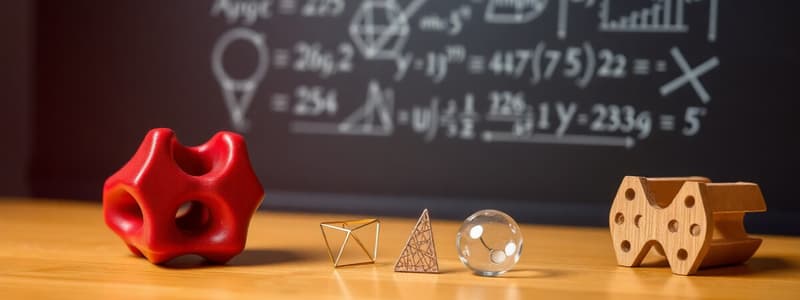Podcast
Questions and Answers
Which mathematical concept is defined as a measure of the instantaneous rate of change of a function?
Which mathematical concept is defined as a measure of the instantaneous rate of change of a function?
- Integrals
- Derivatives (correct)
- Continuity
- Limits (correct)
What term describes equations that result in undefined values and often require L'Hôpital's Rule for evaluation?
What term describes equations that result in undefined values and often require L'Hôpital's Rule for evaluation?
- Continuous Functions
- Matrices
- Vectors
- Indeterminate Forms (correct)
Which step in problem-solving involves evaluating whether the solution method and calculations are correct?
Which step in problem-solving involves evaluating whether the solution method and calculations are correct?
- Developing a Strategy
- Verifying the Solution (correct)
- Generalization
- Implementing the Plan
If a function has a property where small changes in input result in small changes in output, it possesses what?
If a function has a property where small changes in input result in small changes in output, it possesses what?
What does the mathematical concept of 'limits' primarily describe?
What does the mathematical concept of 'limits' primarily describe?
Which of the following is NOT a common application of mathematics, as mentioned in the content?
Which of the following is NOT a common application of mathematics, as mentioned in the content?
The mathematical objects used to represent and manipulate data in linear algebra are called?
The mathematical objects used to represent and manipulate data in linear algebra are called?
Which concept is defined as calculating the accumulation of a function across an interval?
Which concept is defined as calculating the accumulation of a function across an interval?
Which branch of mathematics is primarily concerned with operations like addition and multiplication?
Which branch of mathematics is primarily concerned with operations like addition and multiplication?
What does algebra primarily involve?
What does algebra primarily involve?
Which branch of mathematics studies the properties of shapes?
Which branch of mathematics studies the properties of shapes?
What is the primary focus of calculus?
What is the primary focus of calculus?
Which branch deals with the relationships and sizes of angles in triangles?
Which branch deals with the relationships and sizes of angles in triangles?
What does discrete mathematics focus on?
What does discrete mathematics focus on?
Which of the following involves the analysis and interpretation of data?
Which of the following involves the analysis and interpretation of data?
Which branch of mathematics is primarily concerned with logical reasoning and argumentation?
Which branch of mathematics is primarily concerned with logical reasoning and argumentation?
Flashcards
Arithmetic
Arithmetic
The branch of mathematics that deals with numbers, their properties, and operations like addition, subtraction, multiplication, and division.
Algebra
Algebra
A branch of mathematics that uses symbols and variables to represent unknown quantities, allowing for the solving of equations and inequalities.
Geometry
Geometry
The study of shapes, their properties, and measurements, including lines, angles, and geometric figures.
Calculus
Calculus
Signup and view all the flashcards
Statistics
Statistics
Signup and view all the flashcards
Set
Set
Signup and view all the flashcards
Function
Function
Signup and view all the flashcards
Relation
Relation
Signup and view all the flashcards
Proofs
Proofs
Signup and view all the flashcards
Indeterminate Forms
Indeterminate Forms
Signup and view all the flashcards
Limits
Limits
Signup and view all the flashcards
Continuity
Continuity
Signup and view all the flashcards
Derivatives
Derivatives
Signup and view all the flashcards
Integrals
Integrals
Signup and view all the flashcards
Matrices and Vectors
Matrices and Vectors
Signup and view all the flashcards
Problem-Solving Approaches in Mathematics
Problem-Solving Approaches in Mathematics
Signup and view all the flashcards
Study Notes
Introduction to Mathematics
- Mathematics is a fundamental field of study dealing with logic, quantity, and space.
- It involves the study of numbers, shapes, and patterns, as well as their relationships and properties.
- Mathematics has various branches, including arithmetic, algebra, geometry, calculus, and statistics.
- It plays a crucial role in scientific and technological disciplines, and is applied in almost every aspect of modern life.
Branches of Mathematics
- Arithmetic: The basic branch focusing on operations like addition, subtraction, multiplication, and division of numbers.
- Algebra: Deals with symbols and their relationships, extends arithmetic using variables to represent unknowns and solve equations.
- Geometry: Focuses on shapes, their properties, and measurements, studying lines, angles, shapes, and spatial relationships.
- Calculus: Concerned with change and motion, composed of differential (rates of change) and integral (accumulation) calculus.
- Statistics: Involves collecting, organizing, analyzing, interpreting, and presenting data.
- Trigonometry: Relates angle measurements to sides of triangles, useful in navigation and physics.
- Number Theory: Deals with properties of integers and their relationships, including primes, divisibility, and modular arithmetic.
- Discrete Mathematics: Focuses on non-continuous mathematical structures, including combinatorics, graph theory, and logic.
- Linear Algebra: Studies vectors and linear transformations, applied in computer science and engineering, useful for solving systems of equations.
- Abstract Algebra: Studies algebraic structures (groups, rings, fields) in a general, abstract manner.
- Topology: Studies properties of shapes that remain consistent during deformations, stretching, or shrinking.
Fundamental Concepts in Mathematics
- Sets: A collection of well-defined objects.
- Functions: A relationship between sets where each element from the first set is associated with one and only one element in the second set.
- Relations: A connection between sets, which isn't necessarily one-to-one.
- Logic: Deals with reasoning and argumentation using statements and their relationships (implication, conjunction).
- Proofs: A system of logical arguments demonstrating the validity of mathematical statements.
- Indeterminate Forms: Equations resulting in undefined values (like 0/0), requiring special techniques (L'Hôpital's Rule) for evaluation.
- Limits: The behavior of a function as its input approaches a specific value.
- Continuity: A function property where small input changes result in small output changes.
- Derivatives: Measure the instantaneous rate of change of a function.
- Integrals: Calculate the accumulation of a function over an interval.
- Matrices and Vectors: Mathematical objects in linear algebra, representing and manipulating data with multiple components.
Problem-Solving Approaches in Mathematics
- Understanding the Problem: Carefully read and comprehend; identify key elements, provided information, and unknowns.
- Developing a Strategy: Consider various strategies (formulas, diagrams, working backward) and relevant concepts/theorems.
- Implementing the Plan: Execute the chosen strategy, clearly showing steps and calculations.
- Verifying the Solution: Check if the solution makes sense and is mathematically correct.
- Generalization: Extending solution methods to broader or similar problems.
Applications of Mathematics
- Science and Engineering: Essential for modelling natural phenomena, designing structures, and technological advancements.
- Computer Science: Forms the foundation for algorithms, data structures, and artificial intelligence.
- Finance: Used in investment analysis, risk management, and portfolio optimization.
- Statistics: Used for data analysis, prediction, and modelling.
- Business: Used for forecasting, budgeting, and decision-making.
- Everyday Life: Used in cooking, shopping, and various daily activities.
Studying That Suits You
Use AI to generate personalized quizzes and flashcards to suit your learning preferences.




